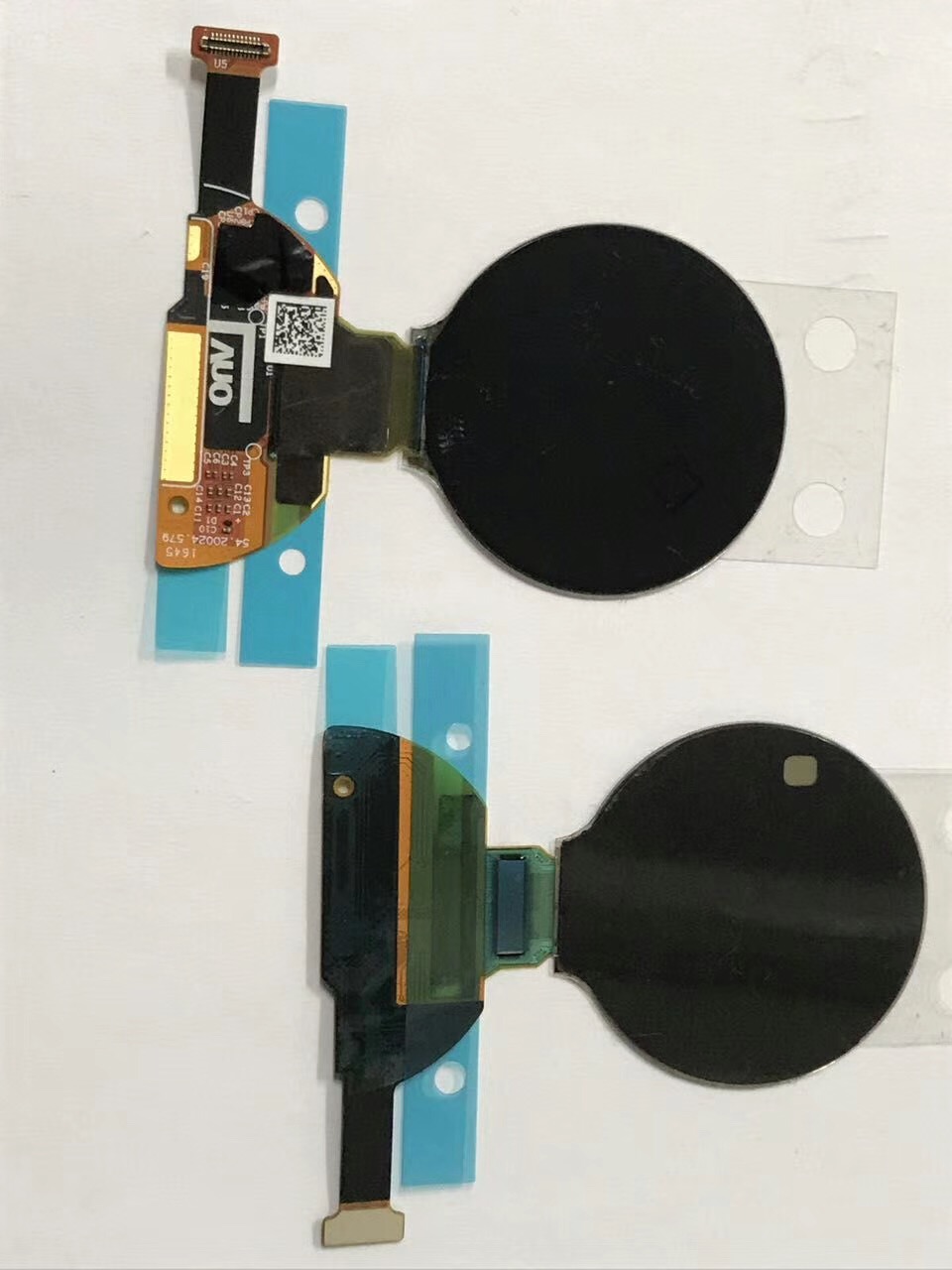 Taiwan's AUO (AU Optronics) was formed in 2001, by the merger of Acer Display and Unipac Optoelectronics. Later in 2006 AUO merged with Quanta Display. AUO is one of the world's largest producers of LCDs.
Taiwan's AUO (AU Optronics) was formed in 2001, by the merger of Acer Display and Unipac Optoelectronics. Later in 2006 AUO merged with Quanta Display. AUO is one of the world's largest producers of LCDs.
In 2006 AUO became the world's first AMOLED producer but in 2007 the company decided to shift focus back to LCD, and stopped investing in OLEDs.
In January 2008 AUO resumed their OLED operation, and after years of development the company started mass producing AMOLEDs again in 2014 at its AFPD fab in Singapore. Over the years AUO developed several innovative OLED technologies such as flexible and bendable panels, transparent OLEDs, OLED lighting, OLED TV panels, inkjet printing and more. In recent years, AUO has shifted its focus to microLED display technology as it cannot compete with leading OLED producers. The company, according to reports, may shut down its AMOLED AFPD fab and convert it to microLED production.
No. 1, Li-Hsin Rd. 2
Hsinchu Science Park
Hsinchu, 30078
Taiwan
Huawei launches four new AMOLED smartphones and wearables
Huawei launched several new devices yesterday, including four new AMOLED ones. The top of the line is the Mate 20 X, a large smartphone that features several high-end technologies - a 7.2" 1080x2244 (346 PPI) AMOLED display, a triple Leica cameras setup, a GoodixTech under-the-display fingerprint sensor, a 5000 mAh battery and a graphene thermal management film.
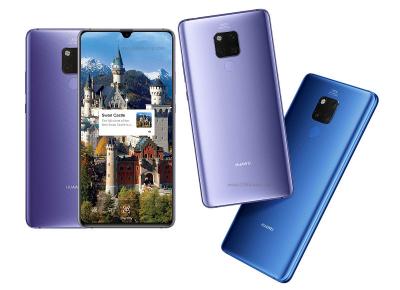
Huawei also launched the smaller Mate 20 Pro - another high-end smartphone that features a 6.39" 1440x3120 (538 PPI) AMOLED display (reportedly produced by BOE), an Octa-Core Kirin 980 (7 nm) chipet, 6GB of RAM, 128 GB of storage, an NM card slot and a triple Leica optics camera setup. The Mate 20 Pro is the first smartphone to adopt Synaptics' complete display system solution - which includes Synaptics’ flexible chip-on-film (COF) ClearView display driver and the company's ClearPad touch controllers.
AUO to establish an OLED ink-jet production line, to make OLEDs for monitors and automotive applications
According to reports from China, Taiwan-based AU Optronics decided to establish an inkjet OLED production line that will be used to produce OLED monitor displays and OLEDs for automotive applications.

The new OLED line will use production equipment made by Japan's JOLED - who started commercial low-volume production of its own 21.6" 4K OLED panels, at the company's pilot 4.5-Gen line. JOLED also announced plans for a mass production 5.5-Gen line that will be established in Nomi City, Ishikawa Prefecture, by 2020, and similarly to AUO, it is focusing on monitors and automotive applications.
Where are the transparent OLEDs?
Transparent displays are of great interest, and many envision a plethora of possible applications that use transparent screens in the retail, commercial and consumer markets. There are many exciting applications - but none with real and immediate demand.
Many OLED makers are developing transparent OLEDs, and in the past we've seen several producers that introduced such displays to the market - only to halt production a few months later. Device makers are on the lookout for such displays, and are still disappointed even though the technology is ready.
Where are the 2 to 4 inch AMOLED displays?
All AMOLED makers are currently focused on two major markets - smartphone displays and wearable displays. This leaves out an important part of the market - displays that are between 1.5" and 5" in size, and device makers that want to adopt AMOLED displays in this size segment find it impossible to find the displays they want.
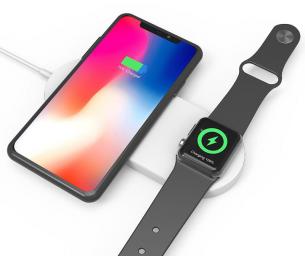
As smartphones grew larger and larger in recent years, the display makers are focusing on 5 to 6.5 inch for their smartphone display portfolio. Wearable AMOLED displays are exclusively aimed towards smartwatches - which use displays sized 1 to 1.5-inch, many of whom are round displays.
CINNO Research details the mobile AMOLED market share by producers
Market analysts from CINNO Research estimate that Samsung Display produced 160.9 million AMOLED displays in H1 2018, which sets SDC's market share in the mobile AMOLED market at 93%. The two other large producers are LG Display and Visionox, both producing 3.5 million panels (2% market share).
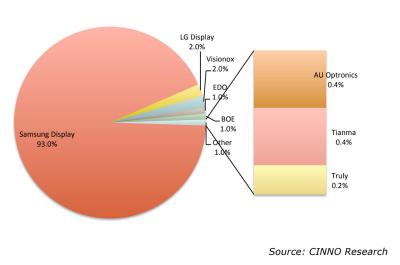
Both Everdisplay (EDO) and BOE produced 1.7 million panels in the first half of 2018 - or about 1% of the market each. AU Optronics and Tianma produced 0.7 million panels (0.4% market share) and Truly closes the list with a market share of 0.2% (400,000 panels).
IHS: LGD is the world's leading AMOLED producer for wearables, followed by SDC, EDO, AUO and BOE
IHS says that LG Display is the world's leading AMOLED supplier for smartwatches and wearables. In 2017 LGD shipped 10.64 million AMOLED displays for smartwatches - and it holds a market share of 41.4% (the total market was 25.7 million units in 2017). LG is the exclusive supplier of AMOLED displays for Apple's watch.

Samsung Displays is the 2nd wearable AMOLED Producer, with a 34.8% market share. Everdisplay has a 16.2% share and AU Optronics shipped 5.7% of all wearable AMOLED shipments in 2017. BOE is the fifth largest AMOLED wearable maker with a market share of 1.5%.
AUO demonstrated its latest OLED and Micro-LED technologies at SID-2018
Taiwan-based AU Optronics (AUO) demonstrated the company's latest OLED, LCD and Micro-LED technologies at SID 2018.
The company had a relatively small OLED demonstration area, showing its True-Circle in-cell Touch AMOLED displays (1.2" and 1.4") unveiled in May 2017. These displays are already shipping. AUO also unveiled its large 13" transparent AR AMOLED (68% transmittance). This transparent OLED was shown for the first time. The 13" panel features a resolution of 1150x575 (100 PPI) and a brightness of 200 nits.
AUO developed a transparent 13" OLED for AR applications
Taiwan's AU Optronics (AUO) developed a 13-inch 100 PPI transparent OLED display, specifically for AR applications. This is a highly-transparent display - with 68% transmittance.
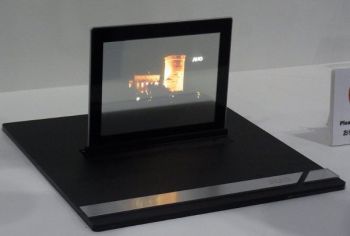
AUO 6" transparent OLED prototype (2011)
To achieve such high transparency, AUO optimized the TFT array layer stack, the OLED cathode pattern and the encapsulation. This is the first transparent OLED AUO has developed since 2011. It will discuss this new display at SID Display 2018 - and will hopefully demonstrate it as well.
SmartKem announces a landmark deal with a Taiwan-based OLED and LCD maker to bring OTFT displays to market
UK-based OTFT developer SmartKem announced that it has signed a landmark deal with a leading display maker in Taiwan that will enable the display maker to commercialize SmartKem's OTFT technology in flexible displays.

The agreement will see a complete technology transfer, including production line deployment and supply of materials. This agreement marks the culmination of the LOI signed in November 2017. SmartKem updates us that this agreement covers both LCD and OLED displays.
AUO launches a new 1.2" 390x390 round AMOLED
AU Optronics launched a new round AMOLED for smartwatches and other applications. This panel is 1.2" in diameter (33.22 x 34.72 mm in size) with a high resolution (390x390, 460 PPI). Click here for more information on this new panel.
Let us know if you are interested in obtaining AUO's latest AMOLED panel, or browse for other OLEDs at our extensive OLED catalog.
Pagination
- Previous page
- Page 2
- Next page


